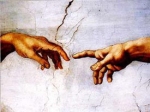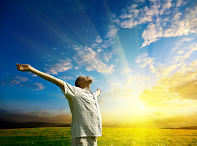Verse: Matt 5:14 "You are the light of the world. A city set on a hill cannot be hidden.” ESV
During the Feast of Tabernacles during Jesus’ day, four large columns were erected and filled with oil in
the outer court of the Temple using old priest robes for wicks. They were ignited and they were called
“the light of the world”. In a culture that had no electricity as we do today, that event was spectacular.
Details of this practice are detailed in the article below.
Normally, upon the conclusion of the afternoon burnt offering, probably around sunset, the
gates of the temple would be closed.(23) However on the first day of the Feast of Tabernacles the
gates were left opened so that all might participate in the final rite of the day, the lighting
ceremony. This occasion proved to be a most joyous and festive observance. From the Mishnah
(Sukkah 5:2-3) we are told that "At the close of the first Holyday" the priests would descend
from the Court of the Israelites to the Court of Women. In the court four huge candelabras were
placed, each "with four golden bowls at their tops and four ladders to each one." Each
candelabra were fifty cubits in height. Wicks made "from the worn-out drawers and girdles of
the priests" were placed in each bowl and lit. It is said that "there was no courtyard in Jerusalem
that was not lit up with the light" which came from these candelabras.
The rest of the night was spent in joyous activities in the Court of Women.
Mishnah Sukkah 5:4 says: “Pious men and men of good deeds used to dance before them (the
candelabras) with burning torches in their hands and sang before them songs and praises. And
the Levites on harps, and on lyres, and with cymbals, and with trumpets and with other
instruments of music without number upon the fifteen steps leading down from the court of the
Israelites to the Women's Court, corresponding to the Fifteen Songs of Ascent in the Psalms
[Psalms 120-134]; upon them the Levites used to stand with musical instruments and sing hymns.
The festivities surrounding the illumination rite concluded the festival day. However, it is not
clear whether or not the illumination rite was done every night, or whether the lights simply
remained lit during the whole feast….”
Jesus is the Light of the World
On the day following the Savior's challenge to come to Him for living water, the Savior was once
again at the Temple teaching. While in the Court of Women, the Savior declared to the
multitude, "I am the light of the world: he that followeth me shall not walk in darkness, but shall
have the light of life" (John 8:12). Could there be any doubt in the minds of his listeners as to
what He was claiming? In the very place where the huge candelabras were lit giving light to
"every courtyard in Jerusalem," symbolizing the continuous light given to all the world during
the Messianic Age, Jesus proclaimed that He was that light. Not only the light of Jerusalem, but
of all the world. Even Jewish tradition held that God gives man light. It is obvious that He was
claiming to be the Messiah in their own hearing.
To give credence to His claim, the Savior demonstrated his power to give light to the world
through a miracle that is recorded only by John. In John 9:1-7, the story of a man born blind
follows on the heels of the Feast of the Tabernacles. The story begins when Jesus "saw a man
which was blind from his birth." When asked why, the Savior responded "that the works of God
should be made manifest in him." Then he said, "I must work the works of him that sent me,
while it is day: the night cometh, when no man can work. As long as I am in the world, I am the
light of the world." Upon that "he spat on the ground, and made clay of the spittle, and he
anointed the eyes of the blind man with the clay, and said unto him, Go, wash in the pool of
Siloam." The man did exactly what he was told. After he had washed his eyes in the same pool
that the priest had drawn water as part of the water drawing ceremony of the Feast of
Tabernacles, he came out seeing.
Two major symbols of the Feast of Tabernacles, water and light, were present in the miracle. By
spiting onto the ground, Jesus demonstrated that indeed the living waters or the Spirit of the
Holy Ghost which can give man light does indeed come from Him, for "out of his belly shall flow
rivers of living water" (John 7:38). This is further emphasized by the washing of the waters in the
pool of Siloam which symbolized the Holy Ghost.
Conclusion
It is undeniable that Jesus' statements during the Feast of Tabernacles are highlighted by the
feast itself. The Savior chose a sacred time of the year when the Jews looked forward with
great rejoicing through ritual action to the coming of the Messiah. Through the
instrumentality of the feast, Jesus declared that He was the promised Messiah; that he was
the literal fulfillment of everything promised in the Feast of Tabernacles. It is clear from the
hostile reactions of the Jews that they saw it this way, supposing that by so doing He was
speaking blasphemy (John 7:30; 32:44-53; 8:59).





Terms & Conditions
Subscribe
Report
My comments